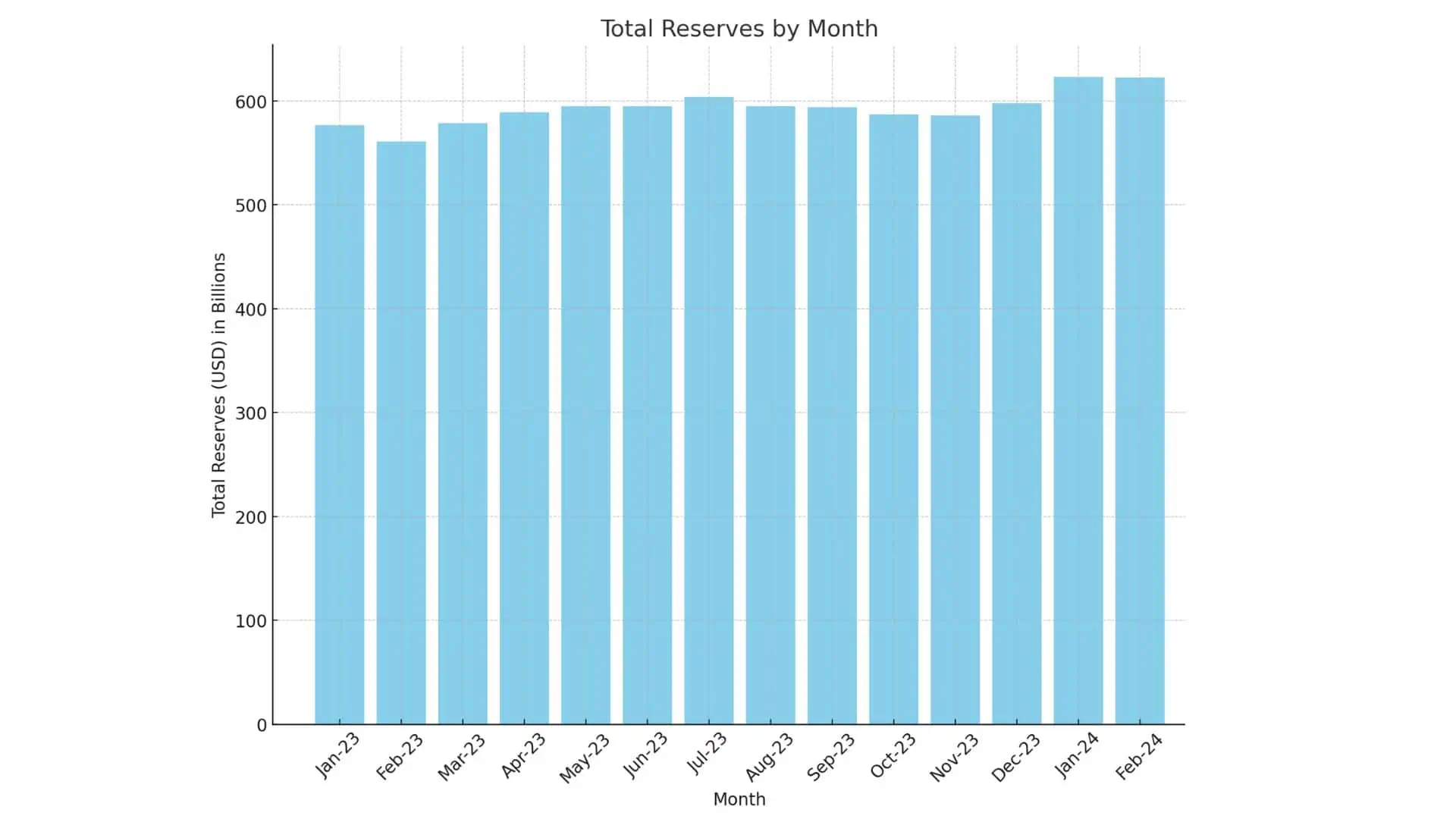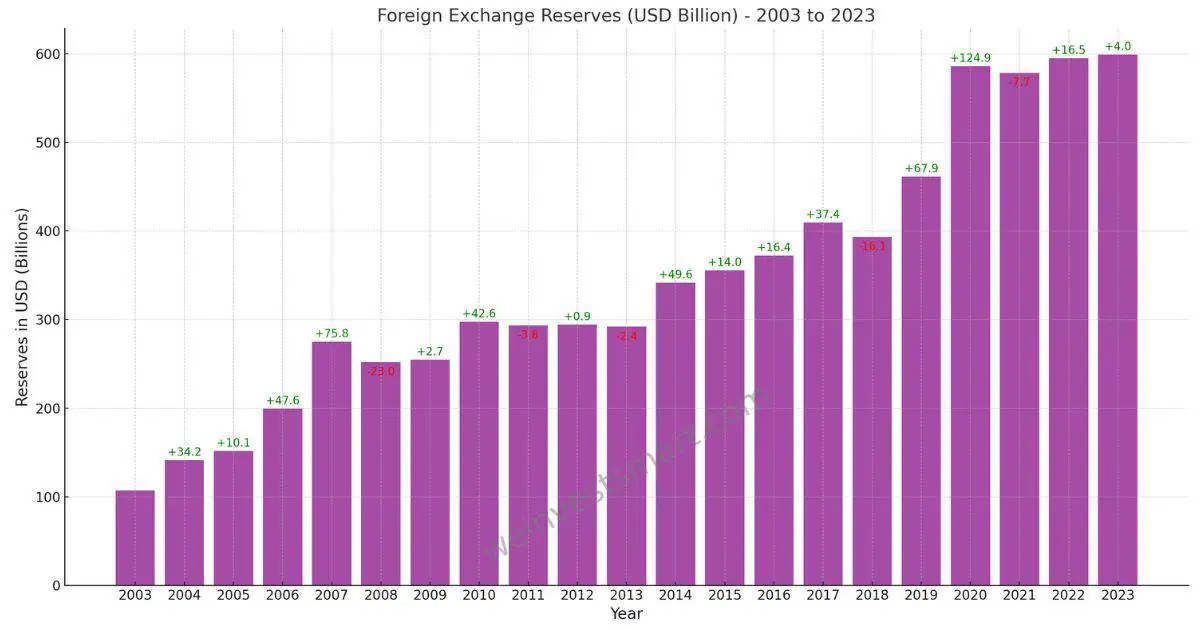India Forex Reserves in 2024 and Historical Data
This post was most recently updated on February 20th, 2024
India’s foreign exchange reserves, also known as India forex reserves, are the foreign assets held or controlled by the Reserve Bank of India (RBI) in foreign currencies. These reserves act as a cushion and provide liquidity, ensuring our country can meet its external obligations. The importance of Indian forex reserves cannot be overstated, as they play a vital role in maintaining the stability of the nation’s currency and economy.

The Indian forex reserves consist of four main components: foreign currency assets, gold reserves, special drawing rights, and the reserve position in the International Monetary Fund.
As per the latest data from the RBI, the exact amount of Indian forex reserves held by different components as of February 2, 2024, is USD 622.46 Billion
Consider reading: Forex Trading in India
Page Contents
India Forex Reserves in 2023-2024
| Month | Total Reserves (USD) | Foreign Currency Assets (USD) | Gold (USD) | SDRs (USD) | Reserve Position in the IMF (USD) |
|---|---|---|---|---|---|
| Jan-23 | 576.761 | 509.018 | 44.027 | 18.478 | 5.238 |
| Feb-23 | 560.942 | 495.906 | 41.751 | 18.187 | 5.098 |
| Mar-23 | 578.449 | 509.691 | 45.2 | 18.392 | 5.165 |
| Apr-23 | 588.78 | 519.485 | 45.657 | 18.466 | 5.172 |
| May-23 | 595.067 | 526.201 | 45.557 | 18.186 | 5.123 |
| Jun-23 | 595.051 | 527.979 | 43.832 | 18.239 | 5.002 |
| Jul-23 | 603.87 | 535.337 | 44.904 | 18.444 | 5.185 |
| Aug-23 | 594.858 | 527.249 | 44.354 | 18.194 | 5.061 |
| Sep-23 | 593.904 | 526.426 | 44.384 | 18.06 | 5.034 |
| Oct-23 | 586.908 | 520.236 | 43.731 | 17.939 | 5.002 |
| Nov-23 | 586.111 | 517.504 | 45.923 | 17.91 | 4.773 |
| Dec-23 | 597.935 | 528.531 | 46.338 | 18.218 | 18.218 |
| Jan-24 | 623.2 | 551.615 | 48.328 | 18.365 | 4.892 |
| Feb-24 | 622.469 | 551.331 | 48.088 | 18.19 | 4.86 |

Source: RBI
Composition of Forex Reserves in India
Foreign currency assets are the largest component of India’s forex reserves, accounting for about 89% of the total. They include holdings of major currencies such as US dollar, euro, pound sterling, Japanese yen, etc., as well as deposits and bonds of foreign governments and international institutions. Foreign currency assets are valued at current exchange rates.
Gold reserves are the second-largest component of the Indian forex reserves, accounting for about 7.5% of the total. They include gold coins and bullion held by the RBI as well as gold deposits with foreign central banks and international institutions. Gold reserves are valued at current market prices.
Special drawing rights (SDR) are the third-largest component of the Indian forex reserves, accounting for about 3% of the total. They are a type of international reserve asset created by the IMF to supplement its member countries’ official reserves. SDRs are allocated to countries based on their IMF quotas and can be exchanged for freely usable currencies. SDRs are valued based on a basket of five major currencies: the US dollar, euro, Chinese yuan, Japanese yen, and British pound.
The reserve position in the IMF is the smallest component of the Indian forex reserves, accounting for about 0.8% of the total. It represents the amount of India’s quota in the IMF that is not drawn or encumbered by loans or other obligations. It can be used to access IMF resources or make payments to other IMF members. The reserve position in the IMF is valued at current SDR exchange rates.
India Forex Reserves For Last 20 Years
| Year | Foreign Exchange Reserves (USD Billion) |
|---|---|
| 2003 | 107.3 |
| 2004 | 141.5 |
| 2005 | 151.6 |
| 2006 | 199.2 |
| 2007 | 275.0 |
| 2008 | 252.0 |
| 2009 | 254.7 |
| 2010 | 297.3 |
| 2011 | 293.5 |
| 2012 | 294.4 |
| 2013 | 292.0 |
| 2014 | 341.6 |
| 2015 | 355.6 |
| 2016 | 372.0 |
| 2017 | 409.4 |
| 2018 | 393.3 |
| 2019 | 461.2 |
| 2020 | 586.1 |
| 2021 | 578.4 |
| 2022 | 594.9 |
| 2023 | 598.9 |
| 2024 | 622.4 |

Importance of Forex Reserves of India
Forex reserves are important for any country for several reasons. Some of the main benefits of having adequate forex reserves are:
- Managing exchange rate: Forex reserves help to maintain a stable and competitive exchange rate for the domestic currency by intervening in the foreign exchange market when needed. A stable exchange rate helps to promote trade and investment flows, reduce inflationary pressures, and enhance confidence in the economy.
- Meeting external obligations: Forex reserves help to meet external obligations such as debt servicing, import payments, and international commitments. Having sufficient forex reserves ensures that the country can honor its financial obligations without facing any liquidity crisis or default risk.
- Cushioning against shocks: Forex reserves help to cushion against external shocks such as sudden capital outflows, global financial crises, or geopolitical tensions. Having adequate forex reserves enables the country to withstand adverse situations without resorting to drastic measures such as capital controls or devaluation.
- Enhancing creditworthiness: Forex reserves help to enhance the country’s creditworthiness and sovereign rating by demonstrating its ability to repay its debts and maintain macroeconomic stability. A higher credit rating helps to lower the cost of borrowing and attract more foreign capital inflows.
Why India’s Forex Reserves are Rising
India’s forex reserves have been rising steadily over the past few years, reaching a record high of $642.45 billion on July 14, 2023. There are several factors that have contributed to this impressive growth in India’s forex reserves:
- Surge in foreign direct investments (FDI): India has emerged as one of the most attractive destinations for FDI in recent years, thanks to its large market size, favorable demographics, policy reforms, and growth potential. According to the UNCTAD World Investment Report 2023, India ranked fifth among the top FDI recipients in 2022 with $64 billion inflows, up from $51 billion in 2021.
- Growth in IT and service exports: India has a strong comparative advantage in IT and service sectors such as software, business process outsourcing, tourism, education, health care, etc. These sectors have been resilient amid the COVID-19 pandemic and have continued to generate foreign exchange earnings for the country. According to RBI data, India’s service exports amounted to $222.6 billion in 2022-23, up from $204.5 billion in 2021-22.
- Prudent economic policies: India has adopted prudent economic policies to maintain fiscal discipline, contain inflation, and boost growth. The government has implemented several reforms to improve the ease of doing business, attract foreign investment, and promote digitalization. The RBI has pursued a flexible inflation targeting regime, a market-determined exchange rate system, and an accommodative monetary policy stance. These policies have helped to enhance the credibility and resilience of the Indian economy.
- Global financial conditions: India has also benefited from favorable global financial conditions such as low-interest rates, ample liquidity, and strong risk appetite among investors. The US Federal Reserve’s dovish stance, the IMF’s massive liquidity injection through SDR allocation, and the global economic recovery have supported the inflow of foreign capital into emerging markets like India. India has also diversified its sources of foreign exchange by tapping into new markets such as the International Financial Services Centre (IFSC) at GIFT City and the Masala bond market.
Consider reading: Best IT Companies in India
How Forex Reserves Help India
India’s Forex reserves helps India achieve various economic objectives, such as:
- Promoting trade and investment: Forex reserves help facilitate trade and investment by providing foreign exchange for importing goods and services, paying for foreign technology and expertise, and acquiring foreign assets and businesses. Forex reserves also help to attract foreign investors by signaling the country’s economic strength and stability.
- Supporting growth and development: Forex reserves help to support growth and development by providing resources for financing public expenditure, infrastructure projects, social welfare programs, and human capital development. Forex reserves also help to foster innovation and entrepreneurship by enabling access to global markets and opportunities.
- Maintaining financial stability: Forex reserves help to maintain financial stability by providing a buffer against external shocks, mitigating currency risks, and enhancing confidence in the financial system. Forex reserves also help to prevent balance of payments crises, currency crises, and sovereign debt crises by ensuring adequate liquidity and solvency.
Consider reading: Best Forex Trading Apps in India
Final Thoughts on India Forex Reserves
India’s forex reserves are a valuable asset that reflects the country’s economic performance and potential. Having adequate forex reserves enables India to pursue its economic goals with confidence and flexibility.
India should continue to build its forex reserves by enhancing its export competitiveness, attracting more FDI inflows, implementing sound economic policies, and diversifying its sources of foreign exchange.
FAQs on India Forex Reserves
How much is India’s forex reserves?
According to the most recent information provided by the RBI, the precise figure for India’s foreign exchange reserves allocated across various components as of September 8, 2023, stands at USD 593.90 billion.
Which country has the largest forex reserves?
As of 2022, China boasts the highest forex reserves globally, totaling more than $3.4 trillion. This impressive reserve stockpile has been primarily fueled by a combination of factors, including a substantial trade surplus, foreign investments, and stringent controls on capital outflows.
Why India has high forex reserves?
The Reserve Bank of India (RBI) accumulates foreign currency reserves through open market operations, purchasing from authorized dealers. India’s foreign exchange reserves serve as a safeguard against rupee volatility, particularly when global interest rates begin to rise.





